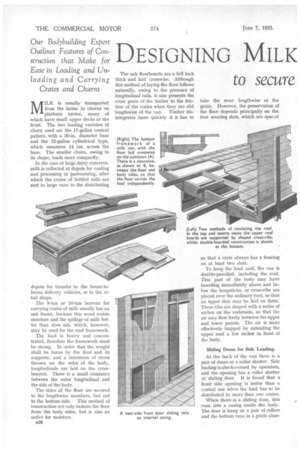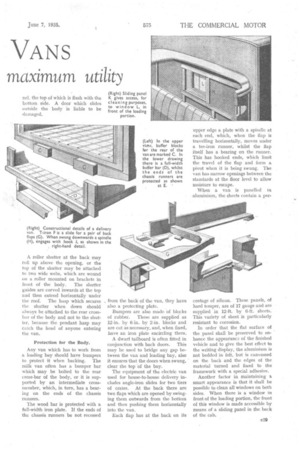DESIGNING MILK VANS
Page 42

Page 43

If you've noticed an error in this article please click here to report it so we can fix it.
to secure
maximum utility
Our Bodybuilding Expert Outlines Features of Construction that Make for Ease in Loading and Unloading and Carrying Crates and Churns MILK is usually transported from the farms in churns on platform lorries, many of which have small upper decks at the front. The two leading varieties of churn used are the 17-gallon conical pattern with a 20-in, diameter base and the 12-gallon cylindrical type, which measures 14 ins, across the base. The smaller churn, owing to its shape, loads more compactly.
In the case of large dairy concerns, milk is collected at depots for cooling and processing or pasteurizing, after which the crates of bottled milk are sent in large vans to the distributing
depots for transfer to the house-tohouse delivery vehicles, or to the retail shops.
The 8-ton or 10-ton boxvari for carrying crates of milk usually has an oak frame, because this wood resists moisture and the spillage of milk better than does ash, which, however, may be used for the roof framework.
The load is heavy and concentrated, therefore the framework must be strong. In order that the weight shall be borne by the door and its supports, and a minimum of stress thrown on the sides of the body, longitudinals are laid on the crossbearers. There is a small clearance between the outer longitudinal and the side of the body.
The sides of the floor are secured to the lengthwise members, but not to the bottom side. This method of construction not only isolates the floor from the body sides, but is also an outlet for moisture. The oak floorboards are a full inch thick and laid crosswise. Although this method of laying the floor follows naturally, owing to the presence of longitudinal rails, it also presents the cross grain of the timber to the friction of the crates when they are slid lengthwise of the van. Timber disintegrates more quickly if it has to so that a crate always has a bearing on at least two slats.
To keep the load cool, the van is double-panelled, including the roof. This part of the body may have boarding immediately above and below the hoopsticks, or cross-ribs are placed over the ordinary roof, so that an upper skin may be laid on them. These ribs are shaped with a series of arches on the underside, so that the air may flow freely between the upper and lower panels. The air is more effectively trapped by extending the upper roof a few inches in front of the body.
Sliding Doors for Side Loading.
At the back of the van there is a pair of doors or a roller shutter. Side loading is also favoured by operators, and the opening has a roller shutter or' sliding door. It is found that a front side opening i3 better than a central one when the load has to be distributed to more than one centre.
When there is a sliding door, this runs into a casing inside the .body. The door is hung on a pair of rollers and the bottom runs in a guide chan
A roller shutter at the back may roll up above the opening, or the top of the shutter may be attached to two wide webs, which are wound on a roller mounted on brackets in
front of the body. The shutter guides are curved inwards at the top and then extend horizontally under the roof. The hasp which secures the shutter when down should always be attached to the rear crossbar of the body and not to the shutter, because the pendant hasp may catch the head of anyone entering the van.
Protection for the Body.
Any van which has to work from a loading bay should have bumpers to protect it when backing. The milk van often has a bumper bar which may be bolted to the rear cross-bar of the body, or it is supported by an intermediate crossmember, which, in turn, has a bearing on the ends of the chassis runners.
The wood bar is protected with a full-width iron plate. If the ends of the chassis runners be not recessed from the back of the van, they have also a protecting plate.
Bumpers are also made of blocks of rubber. These are supplied as 12-in. by 6-in. by 2-in, blocks and are cut as necessary, and, when fixed, have an iron plate encircling them.
A dwarf tailboard is often fitted in conjunction with back doors. This may be used to bridge any gap between the van and loading bay, also it ensures that the doors when swung, clear the top -of the bay.
The equipment of the electric van used for house-to-house delivery includes angle-iron slides for two tiers of crates. At the back there are two flaps which are opened by swinging them outwards from the bottom and then pushing them horizontally into the van.
Each flap has at the back on its upper edge a plate with a spindle at each end, which, when the flap is travelling horizontally, moves under a tee-iron runner, whilst the flap itself has a bearing on the runner. This has hooked ends, which limit the travel of the flap and form a pivot when it is being swung. The van has narrow openings between the standards at the floor level to allow moisture to escape.
When a van is panelled in aluminium, the sheets contain a per
centage of silicon. These panels, of hard temper, are of 17 gauge and are supplied in 12-ft. by 6-ft. sheets. This variety of sheet is particularly resistant to corrosion.
In order that the flat surface of the panel shall be preserved to enhance the appearance of the finished vehicle and to give the best effect to the writing display, the aluminium is not bedded in felt, but is canvassed on the back and the edges of the material turned and fixed to the framework with a special adhesive.
Another factor in maintaining a smart appearance is that it shall be possible to clean all windows on both sides. When there is a window in front of the loading portion, the front of this window is made accessible by means of a sliding panel in the hack of the cab.




























































































